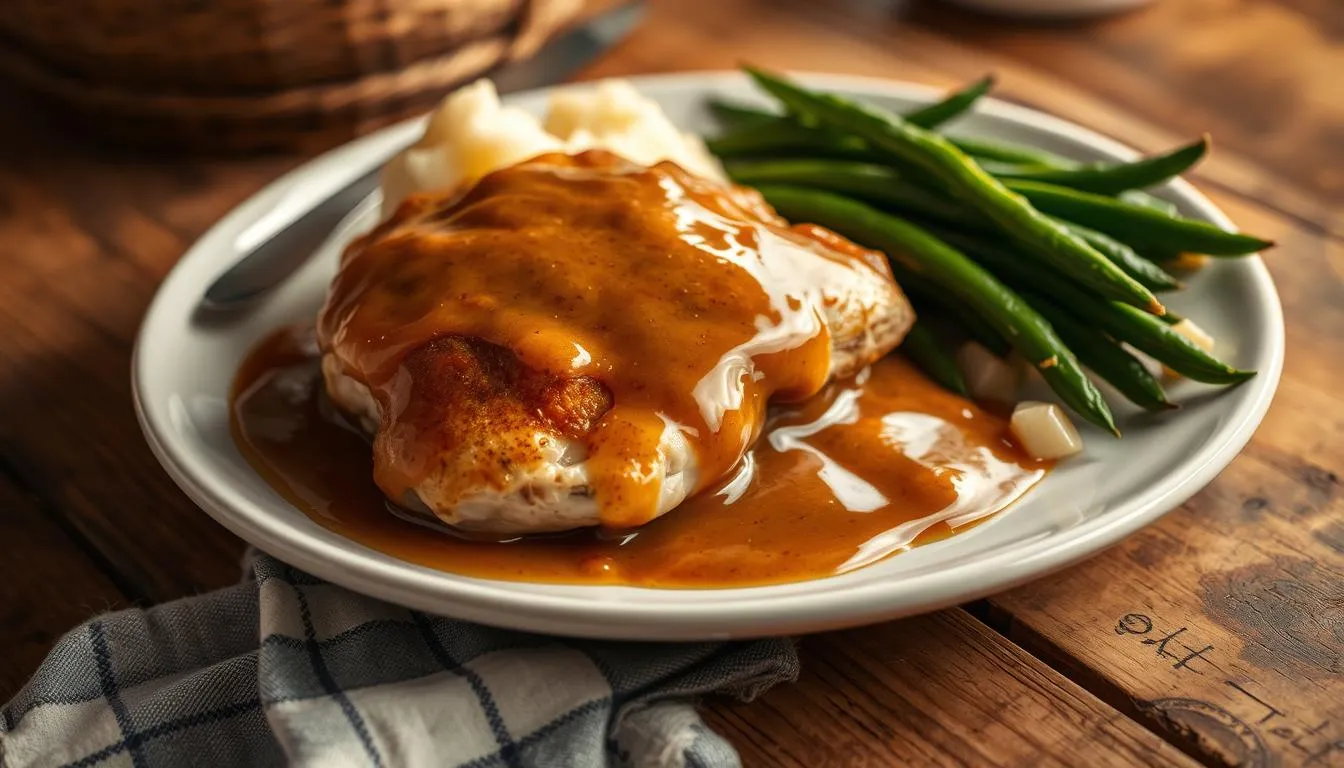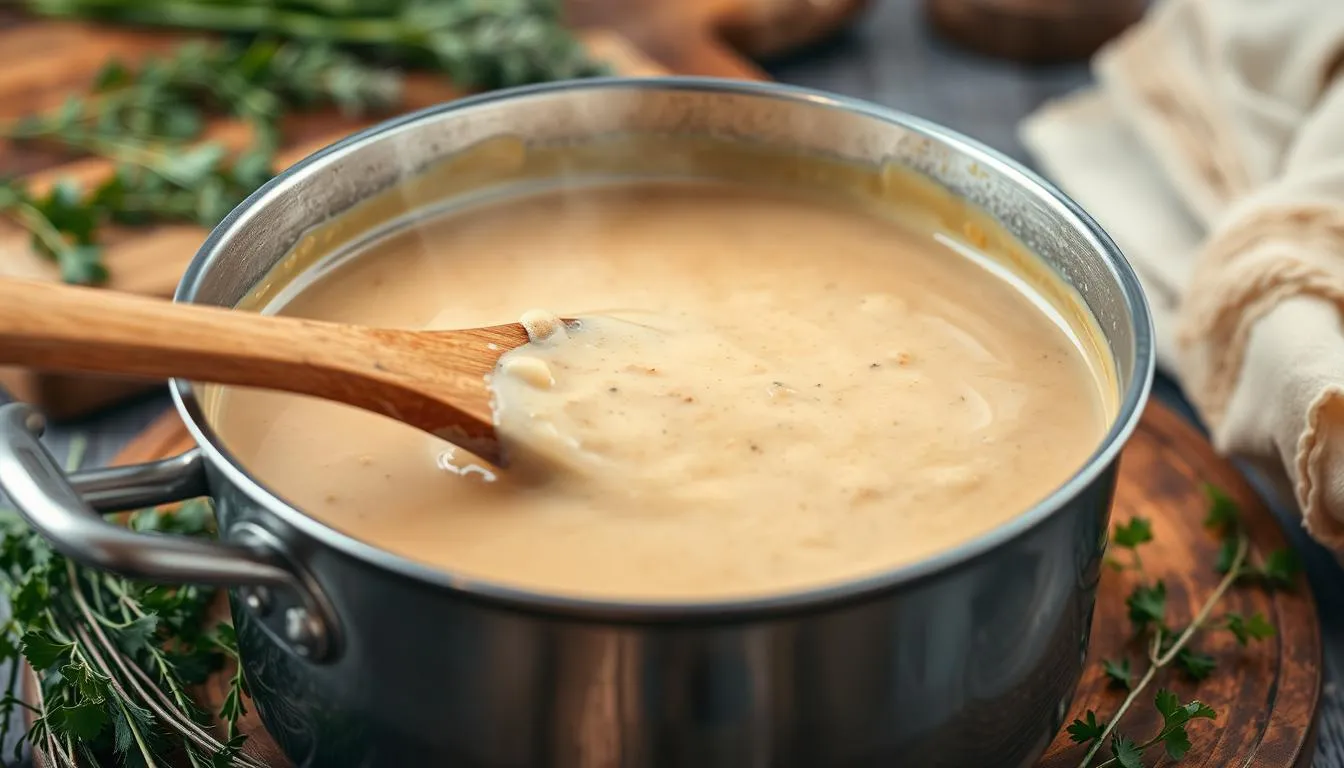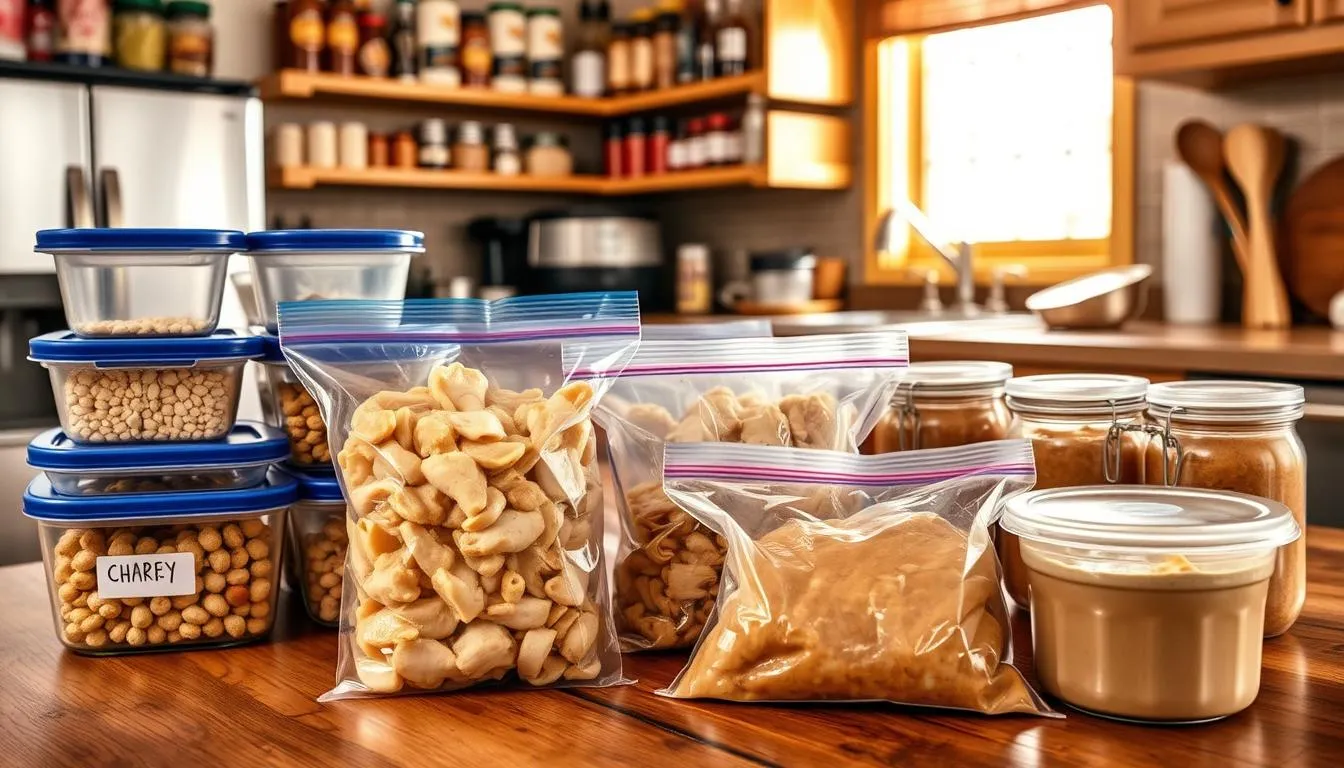Every kitchen has a special recipe that brings families together. The classic chicken and gravy recipe is a perfect example. It’s more than just a meal; it’s a warm hug on a plate that connects generations.
When you make a traditional chicken and gravy recipe, you’re doing more than cooking. You’re creating a culinary experience that touches the heart of American home cooking. This dish has been a favorite in many homes, turning simple ingredients into something amazing.
The beauty of homemade comfort food is in its simplicity and rich flavors. A well-cooked chicken with smooth gravy can make any dinner special. It brings warmth and comfort to your table, creating lasting memories.
Key Takeaways
- Chicken and gravy represents classic American home cooking
- The dish connects generations through shared culinary traditions
- Simple ingredients can create extraordinary meals
- Homemade comfort food provides emotional and nutritional satisfaction
- Cooking brings families together around the dinner table
Understanding the Magic Behind Perfect Chicken and Gravy
Chicken and gravy are more than a meal. They are a beloved tradition in American comfort food. This classic mix has warmed hearts and filled bellies for years, linking food to memories.
The history of chicken and gravy is rich and varied. It has evolved from simple farm kitchens to fancy dining rooms. This shows how American food has changed over time.
Exploring the Historical Roots
Regional chicken recipes have shaped our love for chicken and gravy. Each part of the United States has its own way of making it:
- Southern-style creamy gravy with black pepper
- Midwestern hearty chicken and thick gravy
- Cajun-inspired spicy chicken preparations
Why Chicken and Gravy Are a Perfect Match
The beauty of chicken and gravy is how they complement each other. The chicken is tender and juicy, while the gravy:
- Adds rich, complex flavors
- Keeps the chicken moist
- Brings a nice texture
“Chicken and gravy is not just food; it’s a culinary embrace that connects generations.” – Chef Maria Rodriguez
Regional Variations Across America
| Region | Unique Gravy Characteristic | Primary Flavor Profile |
|---|---|---|
| Southwest | Chili-infused gravy | Spicy and bold |
| New England | Cream-based gravy | Subtle and smooth |
| Midwest | Thick, pepper-rich gravy | Hearty and robust |
Knowing these regional differences helps us see the rich variety of chicken and gravy in the United States.
Essential Ingredients for Authentic Chicken and Gravy
Making a real chicken and gravy recipe begins with picking the right stuff. The heart of a tasty meal is in the quality and mix of your chicken and gravy ingredients.
For the best chicken base, go for top-notch poultry. Bone-in chicken gives the most flavor and richness. Choose fresh, organic chicken for the best taste and texture.
- Chicken (whole or pieces)
- All-purpose flour
- Chicken broth
- Butter or oil
- Salt and pepper
Your authentic gravy recipe needs a few key things to turn simple ingredients into a delicious sauce. The secret is the roux – a mix of fat and flour that makes a smooth, rich base.
| Ingredient | Purpose | Recommended Quantity |
|---|---|---|
| All-Purpose Flour | Thickening agent | 1/4 cup |
| Chicken Broth | Liquid base | 2 cups |
| Unsalted Butter | Flavor and fat | 4 tablespoons |
“The magic of chicken and gravy lies in the simplicity of its ingredients and the love you put into preparing them.” – Home Cooking Wisdom
Want to make your chicken and gravy even better? Try adding fresh herbs like thyme or rosemary. They add a special depth to your gravy.
The secret to a fantastic chicken and gravy dish is using fresh, quality ingredients and cooking with love.
Kitchen Tools and Equipment You’ll Need
Creating tasty chicken and gravy needs more than just good ingredients. The right cookware can make a big difference. It can turn your dish from good to great. Choosing the right tools for making gravy is key to getting restaurant-quality results.
Must-Have Cookware
- Large Cast Iron Skillet: Perfect for even heat distribution and creating rich, flavorful gravies
- Heavy-Bottom Saucepan: Ideal for smooth gravy preparation
- Roasting Pan: Essential for cooking chicken with maximum flavor retention
Optional but Helpful Tools
- Fat Separator: Helps remove excess grease from pan drippings
- Whisk: Creates smooth, lump-free gravy
- Meat Thermometer: Ensures perfect chicken doneness
Measuring and Timing Equipment
| Tool | Purpose |
|---|---|
| Measuring Cups | Precise ingredient measurements |
| Kitchen Scale | Accurate weight measurements |
| Digital Timer | Precise cooking time tracking |
“The right tools can turn an ordinary meal into a culinary masterpiece.” – Professional Chef
Pro tip: Invest in quality kitchen tools. They’ll make your chicken and gravy preparation easier and more enjoyable.
Preparing Your Chicken for the Perfect Result
Mastering chicken preparation techniques is key to a delicious chicken and gravy. Before cooking, knowing the right methods can turn a simple meal into a feast.
Your chicken preparation journey starts with picking the right cut and cleaning it well. Here are key steps for tasty results:
- Trim excess fat and remove any unwanted skin
- Rinse chicken thoroughly under cold water
- Pat dry with paper towels to remove moisture
Marinating chicken for gravy is important. The right marinade adds flavor and makes the meat tender. Here are some tips:
- Use acidic ingredients like buttermilk or lemon juice
- Marinate for 2-4 hours in the refrigerator
- Season with herbs and spices that complement your gravy
“The key to great chicken is preparation – it’s where the magic begins.” – Professional Chef
Temperature is critical in chicken preparation. Always let your chicken rest at room temperature for 15-20 minutes before cooking. This ensures even cooking and prevents dry meat.
Pro tip: For the most succulent results, brine your chicken before cooking. A simple salt water solution can dramatically improve moisture and flavor, setting the stage for an incredible gravy.
The Best Chicken and Gravy Recipe for Beginners
Making an easy chicken and gravy recipe is simple. This beginner-friendly recipe will guide you to a delicious meal. It’s sure to impress your family and friends.
Cooking chicken with homemade gravy is easy. It just needs some basic techniques. As you follow each step, you’ll feel more confident in the kitchen.
Essential Ingredients for Success
- 4 boneless, skinless chicken breasts
- 2 cups chicken broth
- 1/4 cup all-purpose flour
- 2 tablespoons butter
- Salt and pepper to taste
Step-by-Step Cooking Instructions
- Season chicken breasts with salt and pepper
- Heat butter in a large skillet over medium heat
- Cook chicken for 6-7 minutes per side until golden brown
- Remove chicken and set aside
- Sprinkle flour into pan drippings to create gravy base
- Slowly whisk in chicken broth until smooth
Common Mistakes to Avoid
When making this easy chicken recipe, avoid these mistakes:
- Don’t overcook chicken – it can become dry
- Whisk gravy continuously to prevent lumps
- Maintain medium heat to prevent burning
Timing and Temperature Guidelines
Cooking chicken needs precision. Use a meat thermometer to check the chicken’s internal temperature. It should be 165°F. Also, let your gravy simmer gently to keep it smooth.
“Cooking is about confidence and having fun in the kitchen!” – Julia Child
This easy chicken and gravy recipe is great for beginners. With practice, you’ll make meals as good as restaurants in your own kitchen.
Mastering the Art of Smooth, Lump-Free Gravy
Making the perfect gravy takes skill and patience. Your smooth gravy techniques can turn a simple meal into a masterpiece. Learning the secrets of lump-free gravy tips will boost your cooking confidence.
The secret to smooth gravy is in the preparation. Choosing the right thickening agent is key. Flour and cornstarch are popular choices, each with its own benefits.
- Flour-based gravies work best with pan drippings
- Cornstarch creates a glossier, more translucent gravy
- Whisk constantly to prevent lumps from forming
“The difference between good and great gravy is in the technique.” – Professional Chef
Smooth gravy techniques require attention to detail. Begin by making a roux, a mix of fat and flour cooked together. This helps avoid lumps. Then, add liquid slowly while whisking, for a silky texture.
Temperature control is vital for lump-free gravy tips. Use medium heat and stir constantly to avoid clumps. A flat whisk is best for mixing ingredients smoothly.
- Heat your fat or drippings
- Add flour slowly
- Whisk vigorously
- Pour liquid in small increments
- Continue stirring until desired consistency
Practice is key to mastering smooth gravy techniques. Don’t worry if your first tries aren’t perfect. With patience and these tips, you’ll soon make sauces that wow your guests.
Tips for Achieving Restaurant-Quality Results
To make your homemade chicken and gravy stand out, follow some expert tips. Professional chefs say the key to great gravy is in the technique and details. They know how to make it taste like it’s from a restaurant.
Professional Chef Secrets
Top chefs say the secret to amazing chicken and gravy is knowing the basics. The flavor and richness of your gravy come from a few important steps:
- Use high-quality chicken stock as the base
- Develop a rich roux by slowly browning flour and butter
- Season gradually and taste frequently
- Strain your gravy for ultimate smoothness
Flavor Enhancement Techniques
For restaurant-style gravy, you need deep flavors. Here are some tips to enhance your sauce:
- Deglaze the pan with white wine or brandy
- Add fresh herbs like thyme or rosemary
- Incorporate a splash of heavy cream for richness
- Finish with a pat of cold butter for shine
“Great gravy is about layering flavors, not just mixing ingredients.” – Professional Chef Michael Roberts
Presentation Tips
The last step in making your chicken and gravy look professional is how you present it. Serve the gravy in a warm sauce boat. Drizzle it over perfectly carved chicken. Garnish with fresh herbs for a restaurant-quality look.
Storing and Reheating Your Chicken and Gravy
Storing chicken and gravy right is key to keeping food safe and flavors fresh. Knowing the best ways to store and reheat can make leftovers taste just as good as the first time.
Refrigeration Guidelines
Here are important tips for storing chicken and gravy:
- Cool the chicken and gravy completely before storing
- Use airtight containers to prevent moisture loss
- Refrigerate within two hours of cooking
- Store in separate containers for best quality
Reheating Gravy Techniques
Reheating gravy needs care to keep it smooth. High heat can make it lumpy. Here’s how to reheat it right:
- Warm gravy slowly in a saucepan over low heat
- Stir continuously to prevent scorching
- Add a small amount of broth or water to restore consistency
- Heat until the gravy reaches 165°F for food safety
Freezing Tips chicken and gravy recipe
Freezing chicken and gravy is great for long-term storage. Pro tip: Freeze gravy in smaller portions for easier reheating. Most chicken and gravy dishes stay good for up to 3 months when sealed well.
“The secret to great leftovers is all in the storage and reheating technique.” – Professional Chef
By using these storage and reheating tips, you’ll always have tasty, safe, and flavorful meals ready.
Perfect Side Dishes to Complement Your Meal
Choosing the right chicken and gravy sides can make your meal unforgettable. The best sides for gravy add flavor and texture, making your meal enjoyable. They create a perfect balance that delights your taste buds.
Classic chicken and gravy sides that never disappoint include:
- Creamy Mashed Potatoes: The ultimate comfort food companion
- Roasted Green Beans
- Buttered Egg Noodles
- Honey-Glazed Carrots
“The right side dish can elevate a simple chicken and gravy meal to a memorable culinary experience.” – Professional Chef
To help you plan your meal, here’s a quick reference for complementary dishes for gravy:
| Side Dish | Flavor Profile | Preparation Time |
|---|---|---|
| Mashed Potatoes | Creamy, Rich | 20 minutes |
| Roasted Vegetables | Savory, Caramelized | 30-40 minutes |
| Garlic Bread | Crispy, Aromatic | 10-15 minutes |
Pro tip: Always consider preparation time to ensure all components of your meal are ready simultaneously. Stagger your cooking to create a perfectly timed, delicious dinner that will impress your family and guests.
Troubleshooting Common Problems
Cooking chicken and gravy can sometimes present unexpected challenges. Don’t worry – even experienced home chefs encounter issues during preparation. This guide will help you navigate through common gravy troubleshooting scenarios and fixing chicken and gravy issues with confidence.
Fixing Thin or Thick Gravy
Gravy consistency can make or break your dish. When your gravy is too thin, try these quick solutions:
- Whisk in a cornstarch slurry (1 tablespoon cornstarch mixed with cold water)
- Simmer the gravy to reduce and thicken naturally
- Add a small amount of instant mashed potato flakes
For overly thick gravy, gradually whisk in warm chicken broth or milk until you reach the desired consistency.
Resolving Flavor Issues
Bland or overseasoned gravy can be rescued with these tricks:
- Add depth with a splash of white wine or chicken stock
- Balance saltiness by incorporating a bit of cream or butter
- Enhance flavor with fresh herbs like thyme or rosemary
“Great gravy is about balance and patience” – Professional Chef Tip
Salvaging Overcooked Chicken
Dry chicken doesn’t mean your meal is ruined. Try these gravy troubleshooting techniques:
- Slice chicken thinly and drench in extra gravy
- Create a moisture-rich sauce with additional broth
- Chop and mix with gravy for a more forgiving texture
Remember, cooking is an art of adaptation. With these strategies, you can turn a kitchen mishap into a delicious meal!
Conclusion-chicken and gravy recipe
Making the perfect homemade comfort food takes patience, practice, and passion. Mastering chicken and gravy is more than just following a recipe. It’s about learning the fine techniques that turn simple ingredients into a memorable meal.
Your journey has taught you key skills. You’ve learned how to pick the best ingredients and get the gravy just right. With each dish, you’ll feel more confident in your cooking.
Cooking is a never-ending learning journey. Don’t get discouraged by mistakes. Every famous chef began where you are now, eager to cook delicious meals. Keep learning, trying new flavors, and trusting your growing skills.
With hard work and the tips from this guide, you’re on your way to becoming a home cooking pro. Your chicken and gravy will soon be a favorite, making memories for everyone.
FAQ
How long can I store homemade chicken and gravy?
Homemade chicken and gravy can stay in the fridge for 3-4 days. Use an airtight container. For longer storage, freeze it for up to 4 months. Make sure to use the right containers to keep the flavor and texture good.
What’s the best way to prevent lumpy gravy?
To avoid lumpy gravy, whisk constantly when adding flour or cornstarch. Mix the thickener with cold liquid before adding it to hot pan drippings. Slowly add the mixture while stirring to get a smooth texture.
Can I make chicken and gravy ahead of time?
Yes, you can make chicken and gravy ahead. Cook the chicken and make the gravy, then store them separately. Reheat gently, adding a bit of chicken broth if needed to keep it moist.
What are the best chicken cuts for this recipe?
Bone-in chicken thighs and chicken breasts are both good choices. Thighs are juicier and more flavorful. Breasts are leaner. Pick what you like more.
How can I make my gravy more flavorful?
To make your gravy taste better, use pan drippings and add herbs like thyme or rosemary. A splash of white wine or rich chicken stock can also help. Season with salt, pepper, and a bit of garlic for extra flavor.
Is it possible to make gluten-free chicken and gravy?
Yes, it’s easy to make gluten-free chicken and gravy. Use gluten-free flour like cornstarch or gluten-free flour blends instead of wheat flour. Make sure all ingredients are gluten-free for a safe, tasty meal.
What side dishes pair best with chicken and gravy?
Side dishes like mashed potatoes, roasted vegetables, and green beans go well with chicken and gravy. Buttermilk biscuits and rice are also great. These sides soak up the gravy and make the meal complete.
How can I rescue gravy that’s too thin or thick?
For thin gravy, simmer it longer or mix a bit of cornstarch with cold water and whisk in. For thick gravy, add warm chicken broth slowly while stirring until it’s right.



